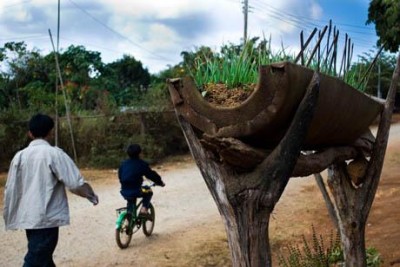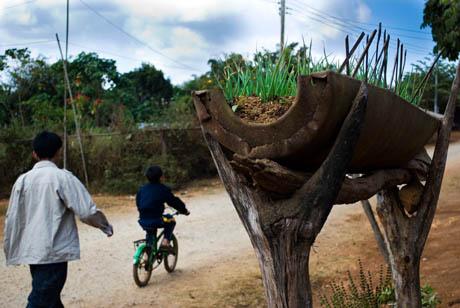 Today, Secretary of State Hillary Clinton arrives in Laos, a stopover on her way to Cambodia to attend the Association of Southeast Asian Nations (ASEAN) Regional Forum. The Secretary’s trip will remain relatively low-profile; after all, news from this small, landlocked, mountainous nation rarely makes the front page. But Clinton’s trip to Laos is actually quite significant – the last time an active Secretary of State visited Laos was in 1955, when Secretary John Foster Dulles arrived in Vientiane, the quaint, sleepy capital of this newly independent nation. Secretary Dulles’ objective was to build relations with the kingdom of Laos in order to prevent it from falling into Communist hands, consistent with the “domino” theory of the time.
Today, Secretary of State Hillary Clinton arrives in Laos, a stopover on her way to Cambodia to attend the Association of Southeast Asian Nations (ASEAN) Regional Forum. The Secretary’s trip will remain relatively low-profile; after all, news from this small, landlocked, mountainous nation rarely makes the front page. But Clinton’s trip to Laos is actually quite significant – the last time an active Secretary of State visited Laos was in 1955, when Secretary John Foster Dulles arrived in Vientiane, the quaint, sleepy capital of this newly independent nation. Secretary Dulles’ objective was to build relations with the kingdom of Laos in order to prevent it from falling into Communist hands, consistent with the “domino” theory of the time.
Unfortunately, diplomacy in the 1950s gave way to more forceful means of deterrence in the 1960s. While the U.S. was officially at war with Vietnam, it also participated in a “secret war” in Laos — which was never formally authorized by Congress and in violation of international accords — to stem Communist ground incursions from the North and to interdict traffic along the Ho Chi Minh Trail in Laos, North Vietnam’s logistical military lifeline to the south. But the people to suffer most were ordinary Lao villagers. Between 1964 and 1973, the United States dropped the equivalent of one planeload of bombs every eight minutes, 24 hours a day, on a country the size of Minnesota. One ton of bombs was dropped for every man, woman, and child in Laos at the time, making it the most heavily bombed country per capita in history.
Almost 40 years have passed since the end of the bombing campaigns over Laos, and U.S.-Lao relations have made impressive strides. After years of cautious engagement, dialogue between the United States and Laos has shifted from the past to the future — on sustainable development and health, trade and investment, increased educational exchange, and cooperation to combat regional issues like narcotics trafficking in the Golden Triangle. Having served as U.S. Ambassador to Laos from 2001 to 2004 and participated in that dialogue, I have continued to watch with deep interest as Laos opens up to the world, and as the world discovers the beauty and economic potential of Laos.
But too many Lao villagers still live daily with that bombing legacy. A significant portion of the bombs dropped on Laos failed to detonate and remain buried in Lao fields, alongside roads, in villagers’ backyards, and even lodged in trees. These bombs, many no larger than an orange, continue to blow up, killing or maiming dozens of people each year. Children are particularly at risk. The United States has contributed funds to help clear these bombs for almost two decades now, but the modest funding hasn’t begun to match the enormity of the problem. An estimated one third of Lao land remains contaminated, making it unavailable for food production or commercial development.
In recent years, I have been more hopeful than ever for a bomb-free future in Laos. At the urging of organizations like Legacies of War and my fellow former chiefs of mission to the U.S. embassy in Laos, Congress has begun to provide levels of funding for bomb clearance more appropriate to the vast scale of the task. I hope that while Secretary Clinton’s visit celebrates a promising future for U.S.-Lao relations, she also affirms to the Lao people America’s steadfast commitment to help Laos and the international community to resolve this legacy once and for all by clearing Lao land of deadly bombs. Forty years may have passed since the last bomb was dropped, but it’s never too late to do the right thing.
